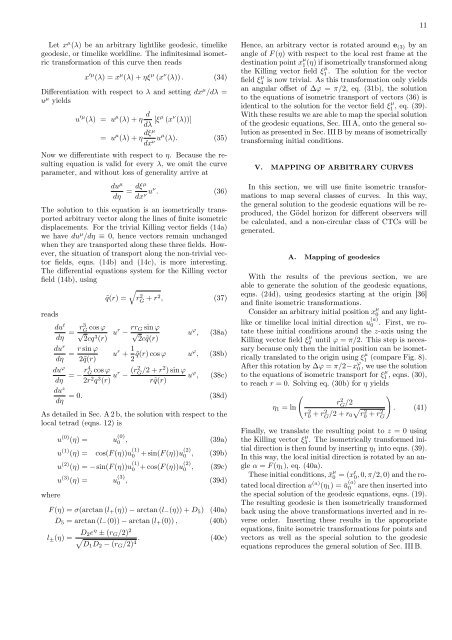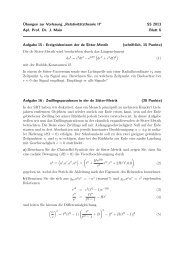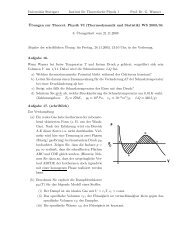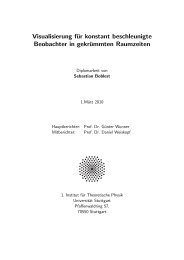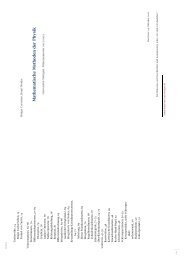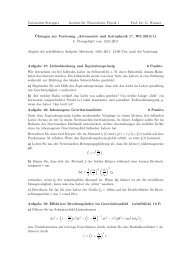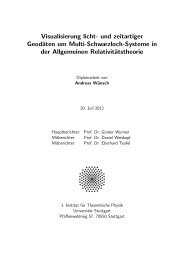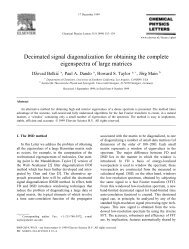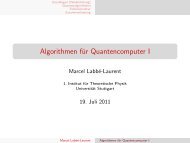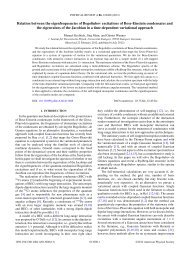The Gödel universe - Institut für Theoretische Physik der Universität ...
The Gödel universe - Institut für Theoretische Physik der Universität ...
The Gödel universe - Institut für Theoretische Physik der Universität ...
Create successful ePaper yourself
Turn your PDF publications into a flip-book with our unique Google optimized e-Paper software.
Let x µ (λ) be an arbitrary lightlike geodesic, timelike<br />
geodesic, or timelike worldline. <strong>The</strong> infinitesimal isometric<br />
transformation of this curve then reads<br />
x ′µ (λ) = x µ (λ) + ηξ µ (x ν (λ)) . (34)<br />
Differentiation with respect to λ and setting dx µ /dλ =<br />
u µ yields<br />
u ′µ (λ) = u µ (λ) + η d<br />
dλ [ξµ (x ν (λ))]<br />
= u µ (λ) + η dξµ<br />
dx ν uµ (λ). (35)<br />
Now we differentiate with respect to η. Because the resulting<br />
equation is valid for every λ, we omit the curve<br />
parameter, and without loss of generality arrive at<br />
du µ<br />
dη<br />
= dξµ<br />
dx ν uν . (36)<br />
<strong>The</strong> solution to this equation is an isometrically transported<br />
arbitrary vector along the lines of finite isometric<br />
displacements. For the trivial Killing vector fields (14a)<br />
we have du µ /dη ≡ 0, hence vectors remain unchanged<br />
when they are transported along these three fields. However,<br />
the situation of transport along the non-trivial vector<br />
fields, eqns. (14b) and (14c), is more interesting.<br />
<strong>The</strong> differential equations system for the Killing vector<br />
field (14b), using<br />
reads<br />
˜q(r) =<br />
<br />
r 2 G + r2 , (37)<br />
dut dη = r3 G cos ϕ<br />
√ u<br />
2cq3 (r) r − rrG sin ϕ<br />
√<br />
2c˜q(r)<br />
u ϕ , (38a)<br />
dur r sin ϕ<br />
=<br />
dη 2˜q(r)<br />
u r + 1<br />
2 ˜q(r)cos ϕ uϕ , (38b)<br />
duϕ dη = − r4 G cos ϕ<br />
2r2q3 (r) ur − (r2 G /2 + r2 )sin ϕ<br />
u<br />
r˜q(r)<br />
ϕ , (38c)<br />
duz = 0.<br />
dη<br />
(38d)<br />
As detailed in Sec. A2b, the solution with respect to the<br />
local tetrad (eqns. 12) is<br />
where<br />
u (0) (η) = u (0)<br />
0 , (39a)<br />
u (1) (η) = cos(F(η))u (1)<br />
0 +sin(F(η))u(2) 0 , (39b)<br />
u (2) (η) = −sin(F(η))u (1)<br />
0 +cos(F(η))u(2) , (39c)<br />
u (3) (η) = u (3)<br />
0 , (39d)<br />
F(η) = σ(arctan (l+(η)) − arctan (l−(η)) + D5) (40a)<br />
D5 = arctan (l−(0)) − arctan (l+(0)) , (40b)<br />
l±(η) = D2eη ± (rG/2) 2<br />
. (40c)<br />
D1D2 − (rG/2) 4<br />
0<br />
11<br />
Hence, an arbitrary vector is rotated around e (3) by an<br />
angle of F(η) with respect to the local rest frame at the<br />
destination point x µ<br />
1 (η) if isometrically transformed along<br />
the Killing vector field ξ µ<br />
1 . <strong>The</strong> solution for the vector<br />
field ξ µ<br />
4 is now trivial. As this transformation only yields<br />
an angular offset of ∆ϕ = π/2, eq. (31b), the solution<br />
to the equations of isometric transport of vectors (36) is<br />
identical to the solution for the vector field ξ µ<br />
1 , eq. (39).<br />
With these results we are able to map the special solution<br />
of the geodesic equations, Sec. III A, onto the general solution<br />
as presented in Sec. III B by means of isometrically<br />
transforming initial conditions.<br />
V. MAPPING OF ARBITRARY CURVES<br />
In this section, we will use finite isometric transformations<br />
to map several classes of curves. In this way,<br />
the general solution to the geodesic equations will be reproduced,<br />
the <strong>Gödel</strong> horizon for different observers will<br />
be calculated, and a non-circular class of CTCs will be<br />
generated.<br />
A. Mapping of geodesics<br />
With the results of the previous section, we are<br />
able to generate the solution of the geodesic equations,<br />
eqns. (24d), using geodesics starting at the origin [36]<br />
and finite isometric transformations.<br />
Consi<strong>der</strong> an arbitrary initial position x µ<br />
0 and any light-<br />
like or timelike local initial direction u (a)<br />
0 . First, we rotate<br />
these initial conditions around the z-axis using the<br />
Killing vector field ξ µ<br />
2 until ϕ = π/2. This step is necessary<br />
because only then the initial position can be isometrically<br />
translated to the origin using ξ µ<br />
1 (compare Fig. 8).<br />
After this rotation by ∆ϕ = π/2−x ϕ<br />
0 , we use the solution<br />
to the equations of isometric transport for ξ µ<br />
1 , eqns. (30),<br />
to reach r = 0. Solving eq. (30b) for η yields<br />
η1 = ln<br />
<br />
r 2 G /2<br />
r2 0 + r2 G /2 + r0<br />
r 2 0 + r 2 G<br />
<br />
. (41)<br />
Finally, we translate the resulting point to z = 0 using<br />
the Killing vector ξ µ<br />
3 . <strong>The</strong> isometrically transformed initial<br />
direction is then found by inserting η1 into eqns. (39).<br />
In this way, the local initial direction is rotated by an angle<br />
α = F(η1), eq. (40a).<br />
<strong>The</strong>se initial conditions, ¯x µ<br />
0 = (xt0,0,π/2,0) and the rotated<br />
local direction u (a) (η1) = ū (a)<br />
0 are then inserted into<br />
the special solution of the geodesic equations, eqns. (19).<br />
<strong>The</strong> resulting geodesic is then isometrically transformed<br />
back using the above transformations inverted and in reverse<br />
or<strong>der</strong>. Inserting these results in the appropriate<br />
equations, finite isometric transformations for points and<br />
vectors as well as the special solution to the geodesic<br />
equations reproduces the general solution of Sec. III B.


